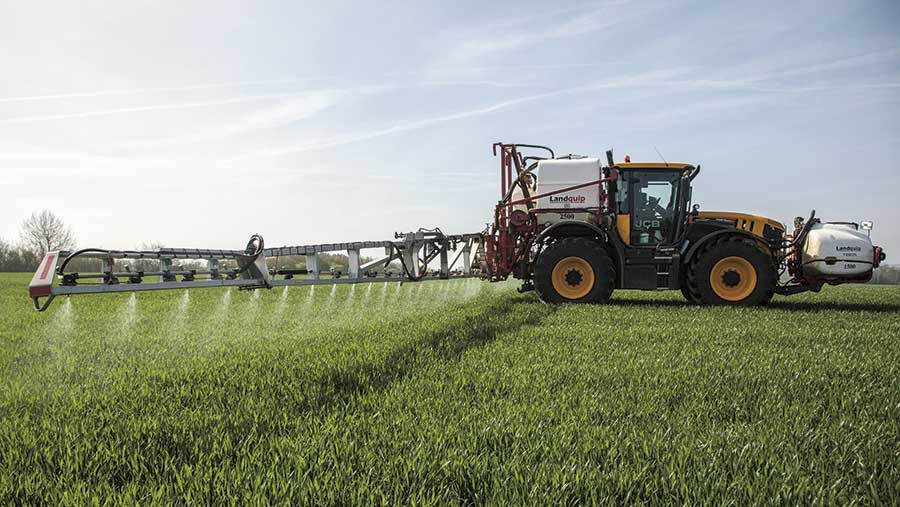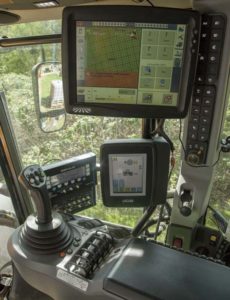Suffolk farmer rates his JCB Fastrac 4000 and Landquip demount sprayer
Demount sprayers have often been panned by the spraying purists, who tend to believe a tailor-made self-propelled is the go-to concept for pesticide application.
Suffolk grower Sam Slater disagrees, however, and the 650ha arable unit – run alongside his father Jonathan and brother Ben – boasts a long history of running a sprayer pack on a JCB Fastrac.
Mr Slater talks Farmers Weekly through why he has resisted the temptation to go for a self-propelled machine and how the recent delivery of a new Fastrac 4220 has made spray days with his Landquip demount something to relish, rather than dread.

© Adam Clarke
See also: 14 self-propelled sprayers compared side-by-side
Why do you favour a demount sprayer?
My father had a demount for many years, so it’s been a long run thing. We have lots of small, odd-shaped fields and that’s always ruled out a trailed machine.
He bought a Landquip at the start, but then we went into a joint venture with a neighbour in 2003 and they had a Fastrac with a Chafer demount on it.

Sam Slater © Adam Clarke
Both sprayers had a 2,000-litre tank and 24m booms and with the rationalisation of the two businesses, we had to get rid of one.
The Chafer was newer and geared up for liquid fertiliser, so it was the one we kept.
Six years later it was up for replacement and we decided to go back to a 2,500-litre Landquip.
When we expanded the contract farming area again in 2011, we added a front 1,500-litre front tank to take our capacity up to 4,000 litres.
Why go for a Landquip?
Compared with other demount sprayer makes, the Landquip is considerably lighter and offers an aluminium boom option.
It’s also much quicker to fit and remove from the tractor and I’ve already had it on and off three times this spring. It’s a 10-minute job, and if the front tank is coming off as well then you can add another five minutes on to that.
Why sit the sprayer on a Fastrac?
The demount on a Fastrac works for us because it’s a way of having great comfort and a good sprayer without the investment or inflexibility of a self-propelled. We’re getting most of the benefits of a self-propelled machine and the compromises we’ve had to make haven’t been a problem for us anyway.
As we’ve expanded, we have had to travel further and you get a safe, high road speed and it’s also possible to use the tractor for other jobs.
What has your new Fastrac brought to the party?
Our previous 3000 series Fastrac was a bit cumbersome. It had a semi-powershift transmission and no four-wheel steer, so the turning circle wasn’t great. Now the 4220 has arrived it has taken the set-up to a whole new level.
JCB have started from scratch and built something very good. We’ve always been Fastrac enthusiasts and like the system, but now I would say it’s fantastic. I have had self-propelled machines on hire in the past – so I’ve got a personal comparison – and I prefer to drive this.
Under clearance is better than the 3000 series and you can also raise and lower the suspension, which is great when you are tired late at night and need to take the sprayer off on your own.
It means I can demount without having to wind jacks to get it off.

© Adam Clarke
The new tractor also has four-wheel steer, so the tractor is much nimbler in corners and the Vario gearbox is a massive step forward.
It’s very smooth and as an operator, it is no different to a hydrostatic motor – you just aren’t so wary on the road.
Did you need to make any modifications?
As our sprayer was designed to marry up to the 3000 series, it required a rebuild for fitting on to the 4000 series because it has a different load platform.
Despite the sprayer being six years old, it was in good condition and had auto section control.
There wasn’t much else that we wanted from a new sprayer, so decided to go down the route of the rebuild rather than replacing it.
Landquip was happy to do it, but it was a tricky exercise. To get the correct boom height, the mast had to be lowered and some other subtle changes to the geometry were required to make sure the booms sat in close to the tractor when folded.
It’s now more compact than it was on the 3000 and I don’t seem to be brushing into hedges as much.
Farm facts
Demeter Farming, Windolphs Farm, Stansfield, Sudbury, Suffolk
- 650ha arable over four sites
- 330ha winter wheat
- 160ha spring oats
- 68ha spring barley
- 30ha winter barley
- 25ha spring beans
- 24ha borage
- 13ha fallow
How does the rig perform?
In terms of performance, I can’t fault it at all. The comfort of the tractor is superb and the 4000 series has a self-levelling suspension system that really helps with boom stability.
One of the arguments for a self-propelled is the ability to maintain a 50:50 weight distribution, but with two tanks you can also move liquid around to help with that, so it’s possible to achieve with this machine, too.
It’s a little heavier than most self-propelleds, but the upshot is that I have good positive drive and grip, so it performs in all conditions.
The tyre size through autumn to spring is 600/70 R30, which has reduced rutting damage and compaction in the tramlines. We then switch to 420/75R 34’s for later in the season, but they are far from narrow and still safe and stable on the road.
Are there any perks to the set-up?
The Fastrac is a high spec tractor and we can use it off the sprayer a lot too. It’s the main cultivation tractor and does a lot of the rolling as well as the spraying, so if the wind is blowing we can take it off and do something else.
Sam Slater’s spray rig
- 217hp Fastrac 4220 with Vario transmission, self-levelling suspension and four-wheel steer
- Landquip demount with 2,500-litre fibreglass tank suitable for fertiliser
- 200-litre fresh water tank for washing
- 24m RA heavy-duty aluminium boom complete with hydraulic tilt
- Pto driven 300-litre/min piston diaphragm pump
- Genius CanBus controller with GPS auto section control of 12x2m sectionsLandquip Vision 1,500-litre front tank
It allows us to operate a slim machinery fleet to keep costs down.
We’ve got just two modern mainline tractors on a five-year replacement policy, plus an older Ford 7810.
We then hire in an extra machine for a few weeks through the summer and autumn.
An extra bonus of the two tanks is that you can have a different mix in the two, so any downsides are offset.
We can also use it for clean water if necessary as well as towing a chemical bowser to more distant fields.
Have you had any problems?
For filling and chemical induction, we did have a couple of issues before the rebuild, but they have been dealt with.
The rear tank level gauge needed improvement and a larger bore pipe was required to the front tank to improve fill speed.
Pump seals are the only other issue we’ve had. Nothing significant has stopped us from using the sprayer for long, so it’s been very reliable.
The Fastrac is generally stable and protects the sprayer from rough ground, so it hasn’t had a hard life.
If you replaced it, are there any extras you would like?
I would have twin lines or nozzles that could be changed at the flick of a switch in the cab. If the acreage grows any further, we might look to increase the boom width to 36m too. I wouldn’t have considered 36m on the old 3000 series Fastrac, but the new one is such a strong and stable platform, I think it would handle it nicely.
Final verdict?
If we still had a 3000 series, I think that self-propelled drivers would find plenty of negatives, but if you put them into this machine I think they would struggle not to be impressed.
Cereals 2017
 The Cereals event is to be held on 14-15 June at the 64ha site just south of Lincoln, with nearly 500 leading suppliers already booked to attend.
The Cereals event is to be held on 14-15 June at the 64ha site just south of Lincoln, with nearly 500 leading suppliers already booked to attend.
Further discounts are available: for groups of 11-20 the price comes down to £19 a ticket; for groups of more than 21 the cost is £18 a ticket.

